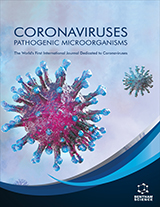Abstract
Background: While the COVID-19 pandemic affected more than thirty million people world-wide, still the true link between COVID-19 and the incidence of stroke remains to be elucidated.
Methods: Herein, we briefly discuss virology of COVID-19 and approaches for diagnosis and treatment of COVID-19 patients, as well as the mechanisms that link stroke and COVID-19. Results: Many pathophysiologic and immunologic mechanisms have been implicated in stroke occurring among patients with COVID-19. COVID-19 pandemic has, in different ways, negative impacts on the care of stroke patients world-wide, and still, neurologists have to face many challenges to improve the care of stroke patients during such crisis. Conclusion: Although the control of the COVID-19 is of crucial importance, at the same time, the management of stroke must not be neglected. Therefore, preserving care for critical conditions such as stroke, and providing strategies to ensure this continues, have a priority even during the crisis. Till vaccine is available for COVID-19, strategies for rapid diagnosis and those for treating patients with that disease are evolving. Further studies are warranted.Keywords: COVID-19, stroke, pathophysiology, outcomes, stroke and COVID, SARS-CoV, COVID virology.
Coronaviruses
Title:Stroke and COVID-19 Pandemic: The Dilemma
Volume: 2 Issue: 8
Author(s): Sherif Mohamed*, Seham Abd El-Mohsen, Osama Abo El-Hassan, Azza AbdelHaffez and Nashwa Abd El-Aziz
Affiliation:
- Department of Chest Diseases and Tuberculosis, Faculty of Medicine, Assiut University, Assiut,Egypt
Keywords: COVID-19, stroke, pathophysiology, outcomes, stroke and COVID, SARS-CoV, COVID virology.
Abstract: Background: While the COVID-19 pandemic affected more than thirty million people world-wide, still the true link between COVID-19 and the incidence of stroke remains to be elucidated.
Methods: Herein, we briefly discuss virology of COVID-19 and approaches for diagnosis and treatment of COVID-19 patients, as well as the mechanisms that link stroke and COVID-19. Results: Many pathophysiologic and immunologic mechanisms have been implicated in stroke occurring among patients with COVID-19. COVID-19 pandemic has, in different ways, negative impacts on the care of stroke patients world-wide, and still, neurologists have to face many challenges to improve the care of stroke patients during such crisis. Conclusion: Although the control of the COVID-19 is of crucial importance, at the same time, the management of stroke must not be neglected. Therefore, preserving care for critical conditions such as stroke, and providing strategies to ensure this continues, have a priority even during the crisis. Till vaccine is available for COVID-19, strategies for rapid diagnosis and those for treating patients with that disease are evolving. Further studies are warranted.Export Options
About this article
Cite this article as:
Mohamed Sherif *, El-Mohsen Abd Seham , El-Hassan Abo Osama, AbdelHaffez Azza and El-Aziz Abd Nashwa , Stroke and COVID-19 Pandemic: The Dilemma, Coronaviruses 2021; 2 (8) : e260721189969 . https://dx.doi.org/10.2174/2666796701666210106112342
| DOI https://dx.doi.org/10.2174/2666796701666210106112342 |
Print ISSN 2666-7967 |
| Publisher Name Bentham Science Publisher |
Online ISSN 2666-7975 |
 51
51
- Author Guidelines
- Bentham Author Support Services (BASS)
- Graphical Abstracts
- Fabricating and Stating False Information
- Research Misconduct
- Post Publication Discussions and Corrections
- Publishing Ethics and Rectitude
- Increase Visibility of Your Article
- Archiving Policies
- Peer Review Workflow
- Order Your Article Before Print
- Promote Your Article
- Manuscript Transfer Facility
- Editorial Policies
- Allegations from Whistleblowers
- Announcements
Related Articles
-
Steerable Sheath Technology in the Ablation of Atrial Fibrillation
Recent Patents on Cardiovascular Drug Discovery Repurposing of Anticancer Drugs for the Treatment of Bacterial Infections
Current Topics in Medicinal Chemistry Systemic Sclerosis: Clinical Manifestations
Current Rheumatology Reviews Clozapine Safety, 40 Years Later
Current Drug Safety Acute Myocarditis in Children: An Overview of Treatment and Recent Patents
Recent Patents on Inflammation & Allergy Drug Discovery Tyrosine Kinase Inhibitors – A Review on Pharmacology, Metabolism and Side Effects
Current Drug Metabolism Familial Mediterranean Fever
Current Rheumatology Reviews Juvenile Systemic Lupus Erythematosus
Current Pediatric Reviews The Role of Point of Care Ultrasound in the Injured Paediatric Patient
Current Pediatric Reviews Role of Nuclear Imaging in Cardiac Amyloidosis Management: Clinical Evidence and Review of Literature
Current Medical Imaging A Comprehensive Systemic Literature Review of Pericardial Decompression Syndrome: Often Unrecognized and Potentially Fatal Syndrome
Current Cardiology Reviews Nitric Oxide and Teratogenesis: An Update
Current Pharmaceutical Design Cardiovascular Involvement in Pediatric Systemic Autoimmune Diseases: The Emerging Role of Noninvasive Cardiovascular Imaging
Inflammation & Allergy - Drug Targets (Discontinued) GnRH-Agonist Triggering to Avoid Ovarian Hyperstimulation Syndrome: A Review of the Evidence
Current Drug Targets Review on Bosentan, A Dual Endothelin Receptor Antagonist for the Treatment of Pulmonary Arterial Hypertension
Recent Patents on Cardiovascular Drug Discovery Cardiovascular Complications of HIV Infection and Treatment
Cardiovascular & Hematological Agents in Medicinal Chemistry Rheumatoid Arthritis: An Autoimmune Disease with Female Preponderance and Cardiovascular Risk Equivalent to Diabetes Mellitus: Role of Cardiovascular Magnetic Resonance
Inflammation & Allergy - Drug Targets (Discontinued) Enasidenib: First Mutant IDH2 Inhibitor for the Treatment of Refractory and Relapsed Acute Myeloid Leukemia
Anti-Cancer Agents in Medicinal Chemistry Treating Nonthyroidal Illness Syndrome in the Critically Ill Patient: Still a Matter of Controversy
Current Drug Targets Kawasakis Disease, Acrodynia, and Mercury
Current Medicinal Chemistry



























